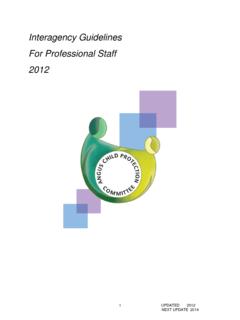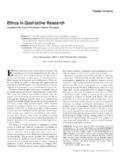Transcription of with child victims of abuse and human trafficking
1 LET S TALKD eveloping effective communicationwith child victims of abuse and human traffickingunicefFor every childHeath, Education, Equality, ProtectionADVANCE HUMANITYUNMIK / GOVERNMENT OF KOSOVO MINISTRY OF LABOUR AND SOCIAL WELFARELET S TALKD eveloping effective communication with childvictims of abuse and human trafficking Practical handbook for social workers, police and other professionalsBarbara Mitchels, September 2004unicefFor every childHeath, Education, Equality, ProtectionADVANCE HUMANITYUNMIK / GOVERNMENT OF KOSOVO MINISTRY OF LABOUR AND SOCIAL age-appropriate information to the child in advance of the the interview to suit the needs of the sure that the child understands the language on the use of to ssttaaggee ooff tthhee appropriate boundaries and ssttaaggee ooff tthhee ssttaaggee ooff tthhee iinntteerrvviieeww:: LLiisstteenniinngg:: wwhhaatt mmaakkeess ccoommmmuunniiccaattiioonn eeffffeeccttiivvee?
2 ? ttoo ccoommmmuunniiccaattiioonn wwiitthh iissssuueess iinn wwoorrkkiinngg wwiitthh aaddoolleesscceennttss aanndd yyoouunngg issues in working with Skills in working with iissssuueess iinn wwoorrkkiinngg wwiitthh cchhiillddrreenn aanndd yyoouunngg ppeeooppllee wwiitthh ssppeecciiaall Basic principles Essential skills and to terms with injuries and help for disabled aanndd qquuaalliittiieess ooff iinntteerrvviieewweerrss 5533 AAppppeennddiixx IITraining exercises to develop interviewing skills 56 BBiibblliiooggrraapphhyy6666 CONTENTSI ntroduction6 Code of conduct7 How to use this CChhiilldd
3 Vviiccttiimmss ooff aabbuussee aanndd ttrraaffffiicckkiinngg of abuse and human of children subject to abuse and needs of child victims of role of social workers following the Stability Pact UNICEF guidelines for the protection of child victims of UUnnddeerrssttaannddiinngg tthhee ppssyycchhoollooggiiccaall aanndd ssoommaattiicc eeffffeeccttss ooff cchhiilldd Posttraumatic Effects of captivity and and behavioural effects of child abuse in children of all effects of traumatic stress of traumatic stress on Burn-out and compassion fatigue in professionals and TThhee ppuurrppoossee ooff iinntteerrvviieewwiinngg cchhiillddrreenn1199 information about the evidence for forensic information to help the child : preparation for referrals ffoorr cchhiilldd which affect child of an interview with child to make an interview a positive the right venue and of toys and play facilities in should interview the child ?
4 Should be present at the interview?294 DEVELOPINGEFFECTIVECOMMUNICATION WITHCHILDVICTIMS OFABUSE ANDHUMANTRAFFICKING5 DEVELOPINGEFFECTIVECOMMUNICATION WITHCHILDVICTIMS OFABUSE ANDHUMANTRAFFICKING7 DEVELOPINGEFFECTIVECOMMUNICATION WITHCHILDVICTIMS OFABUSE ANDHUMANTRAFFICKINGINTRODUCTIONMany of the victims of violence, abuse and humantrafficking are children who have experienced thetrauma of many forms of abuse , sexual, physicaland may have physical illness orpsychological problems as a result of their experi-ences. It is important to understand their needs andto respond to them appropriately. We should try tostop children being further abused after they arefound.
5 Shelters, repatriation and reintegration pro-grammes often are in themselves abusive to the chil-dren that they should be protecting. All professionals and helpers should abide by theUNICEF Guidelines for the Protection of the Rightsof Children victims of trafficking in SoutheasternEurope and the principles of protection and respectfor human rights set out in the United NationsConvention on the Rights of the we sit down to talk with a child , it may bethe first time that the child has been really listenedto, and this is a chance to establish trust and rap-port, to validate the child s experience, and begin toheal the hurts of the past. We need to be sensitive,patient, professional, empathic, and willing to beopen to the child s account of their experiencing,told in their own way.
6 6 DEVELOPINGEFFECTIVECOMMUNICATION WITHCHILDVICTIMS OFABUSE ANDHUMANTRAFFICKINGCODE OF CONDUCT FOR SAFEGUARDING CHILDRENAND YOUNG PEOPLE: DO: Remember that children and young people have the right to respect (thisincludes respect for their physical, intellectual, social and emotional welfare). Respect the cultural, religious and ethnic background of all the people withwhom you work, however different it may be from your own. Model good conduct for others to follow. Ensure that there is always be more than one adult present during activi-ties with children and young people, or the activities should be within thesight and hearing of others. Respect the right of children of personal privacy.
7 Create an atmosphere of trust in which children and young people canchallenge attitudes or behaviours which they do not like. Monitor each other s behaviour with children. Feel able to comment on each other s conduct and be prepared to offerand accept constructive criticism. Challenge any inappropriate behaviour with children. Report any suspicions or allegations of abuse . Be aware that some actions may be misinterpreted, no matter how wellintentioned. Recognise the need to exercise special care and caution in discussing sen-sitive issues with children and young people. Be aware of and comply with the codes of conduct and rules of theagency or organisation with which you are working.
8 Children have the right to decide how much physical contact they havewith others (unless for medical attention). Remember that physical contact should only be that which is necessary forthe activity, it should be age appropriate, and should reflect the child sneeds not those of TO USE THIS HANDBOOKThis handbook is intended to be used as a trainingresource, as a source of information, and to providereferences for future reading and handbook contains information for skills train-ing, for example, the qualities of a good listener, andthe skills required to communicate effectively withchildren. It contains exercises that can be donealone and in groups, which will help to developthese skills, and suggestions for workshops is additional information included in the hand-book relevant to communication with children,including child development, human rights, and othertopics which can be included in handbook can be used as a reference book.
9 Ifyou need more help with a particular problem, forexample, the effect of posttraumatic stress on chil-dren, memory, or difficulty in communicating with achild, consult the index and find the section of thehandbook for ideas and for further researchThe handbook contains references to the research ofothers. The footnotes indicate research and otherworks which can be explored to gain further detailedinformation on specific topics. For teaching purposes, the references are also setout in the Bibliography at the end of the WITHCHILDVICTIMS OFABUSE ANDHUMANTRAFFICKING8 DEVELOPINGEFFECTIVECOMMUNICATION WITHCHILDVICTIMS OFABUSE ANDHUMANTRAFFICKING Physical contact should be initiated by the child , not the adult, unless formedical attention.
10 Seek advice about anyconcerns about the behaviour of any adult withchildren, advice. Ensure that children and young people know of trusted adults ( theschool child protection co-ordinator, or social services) with whom they canshare their concerns, and how to contact those people if they are worriedabout any issue. Have any inappropriate verbal communication with children or youngpeople. Have any inappropriate physical contact with children or young people. Allow yourself to be drawn into inappropriate or attention seekingbehaviour. Make suggestive or derogatory remarks or gestures to (or in front of)children or young people. Jump to conclusions about others without checking the facts.







